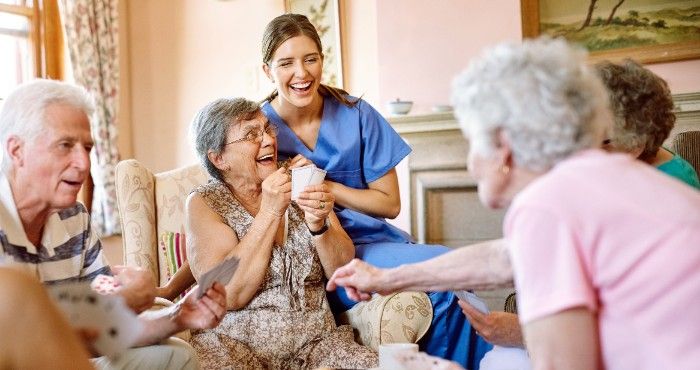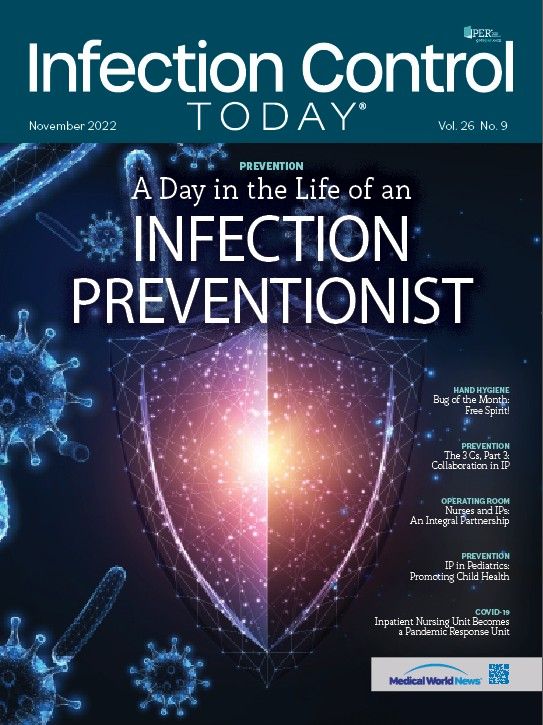Boots on the Ground, or These Boots Are Made for Walking? Some LTC Staff Choose the Latter
Long-term care facilities were once normally happier places, but COVID-19 changed the individuals working and living there. PPEs, testing, overwork, underpayment, and too many isolations have chased health care workers away and forced the facilities' population to plummet. Can anything be done?
Happy times at a nursing home (Adobe Stock)

Back in the spring of 2019, when I first started as an infection preventionist (IP), I was amazed at how lovely working in a nursing home was. Coming from a busy internal medicine practice, this was just the change I was looking for. The facility was decorated for Easter, and numerous residents, family, and staff were sitting in a common area painting Easter eggs. One resident was playing the piano while others sang. This truly was a home. Working as an IP was busy, but seeing the smiles and laughter of the residents made it worth it.
Fast forward to a year later, spring of 2020. When COVID-19 arrived, many things changed within the facility, all related to infection control. As IPs, we were used to quietly working in the background, but now, we were front and center. The regulatory agencies started sending out epidemic orders containing mandatory changes to things such as personal protective equipment (PPE), testing, and vaccine mandates. We were responsible for instituting those changes, many of which nursing home workers never had had to endure before. Employees from all departments were now required to wear source control and be routinely swabbed for COVID-19. Those 2 things alone were enough to start driving some people away from the industry. Wearing an N95, the same N95, for 8-12 hours a day was unprecedented. The guidance for testing specified exactly how many days you had to have in between the screening testing and thus required staff to drive over on a day off to meet the requirements. In our rural community, this meant some staff driving over an hour 1 way to get here. Consequently, staff would correlate these rules and regulations to the IP or administration which would lead to feelings of animosity and frustration.
Compiled with the PPE and testing requirements was the constant stress and anxiety about bringing COVID-19 into the building and possibly giving it to a resident. There was a stigma associated with testing positive now and a strong feeling of guilt and worry as residents were subjected to COVID-19 testing and isolation day after day. There were no more parties, no more singing, and the smiles were covered by masks. As time went on, the regulations on nursing homes became even more demanding; all the while life out in the community was also changing. Many businesses were hurting for staff and offering wages and bonuses most nursing homes couldn’t compete with. Innumerable “help wanted” signs evidenced the general and severe lack of employees in the local economy. PPE fatigue and caregiver burnout were happening at an unparalleled rate, and many health care workers and residents had an overwhelming desire for some sense of normalcy. Staff voiced that they loved caring for their residents but just couldn’t do it anymore.
Anxiety Overload
As an IP, I could relate to all the same things. We were functioning in a constant state of anxiety. Never knowing if a resident sneezed because of allergies or the onset of COVID-19. Most IPs were on call 24/7 now going on 2 and half years, working weekends, holidays, and all hours of the night trying to prevent an outbreak from happening and yet keeping up with all the other non-COVID-19 duties. Health care-associated infections (HAIs) were still happening, the water management program still needed to go on, and employee education never ends. The workload doubled or even tripled when adding in all the mandatory reporting. We were also being held accountable for the actions of visitors entering the facility, some who were confrontational, because as the rest of the world was seemingly moving on, nursing homes were still subject to strict infection control mandates. As misinformation spread, and the war on COVID-19 was now part of the political theatre, the staff had to deal with aggressive and abusive visitors who would refuse to follow our infection control protocols.
Nursing homes have struggled with staffing historically, but the pandemic exacerbated this issue exponentially. For us, it was a gradual decline. We are now staffed about 50% of what we were when the pandemic began. We are also running a census of 50% to parallel that, not for lack of patients on our waiting list, but to ensure we can safely take care of those we have. It has impacted all departments from support staff, to direct care staff, leadership, and administration. After all, we are all human—no matter our job title. We have had to hold an elder’s hand during their last moments because their families were not allowed to come in. We have had to try to keep residents with Alzheimers and dementia isolated to their rooms when they don’t have the cognitive ability to understand why. Many times residents were put into isolation because a staff member tested positive, and the resident, or their family, decided they didn’t want the vaccine or another booster shot. Facility employees continue to test positive, 1 here, 1 there. The regulations state that any resident who is not up-to date with their COVID-19 vaccines should be placed in their room, in quarantine, for at least 7 up to 10 days (it used to be 14), when just 1 staff member tests positive, even if that staff member had no contact with the resident. To put it in perspective, we have not gone 1 month without a positive staff case in over a year.
What Can Be Done?
There is no magical answer to the staffing shortage. I applaud those who have stuck it out, side by side with their colleagues in the trenches. Every nursing home struggles in different areas, but some things can help with staff morale and longevity of employment. We all must work as a team. IPs must feel supported by their administration and the workload shared. It is too much for 1 person to bear alone. All leadership must be visible and accessible.
As an IP, I do rounds every morning, making a point to talk to floor staff, not only to check on the status of residents, but to check on the status of the floor staff themselves. Is there anything I can do to make their day a little easier? While pizza parties are nice, our staff need to truly feel appreciated, and we must continue to invest in their emotional well-being. Our facility hired a success coach to help any employee who may be struggling emotionally, physically, or financially and connects them to resources in the community. Our leadership team members donate a certain dollar amount out of each paycheck to put into an employee assistance program. These funds assist staff with satisfying basic unmet needs such as filling gas tanks, buying groceries, paying for daycare. We also make paid time off donations if someone is adversely affected with time off, especially related to COVID-19. While these things may help retain currently employed staff, it does not propose a solution to bringing in new ones. The staffing mandate from Centers for Medicare & Medicaid Services is another hurdle we will now have to overcome.
We are in a completely different place than we were in 2020. It is time to shift our focus and find our way back to being nursing homes. Somewhere we lost the home part. We have vaccines, therapeutics, prophylactic medications, non-pharmacologic interventions such as mask wearing, and so much more knowledge The outward façade of nursing homes needs to change. Once we are seen as a home again and not an institution, when the singing and dancing return inside these walls, maybe then will we also see a return of caregivers who want to work here again. For me, it’s about the honor and joy of caring for those who once cared for us.
